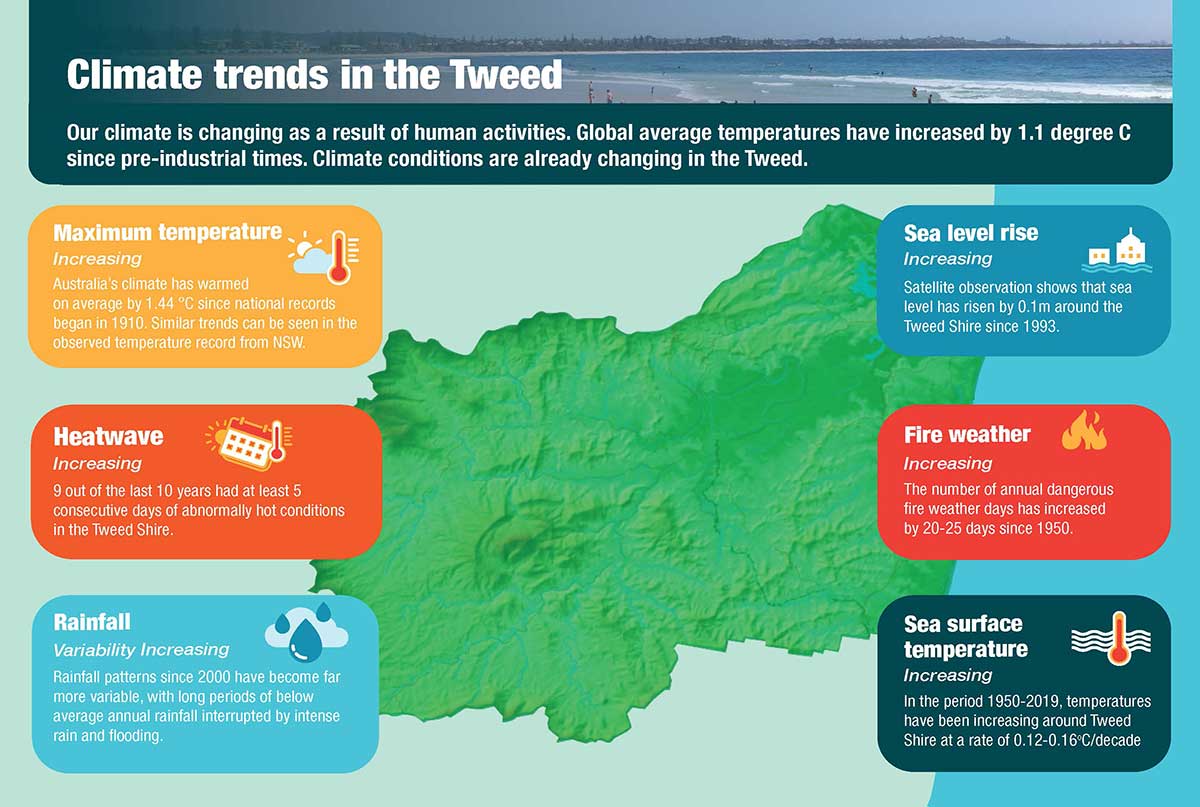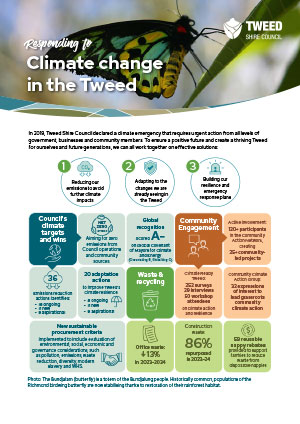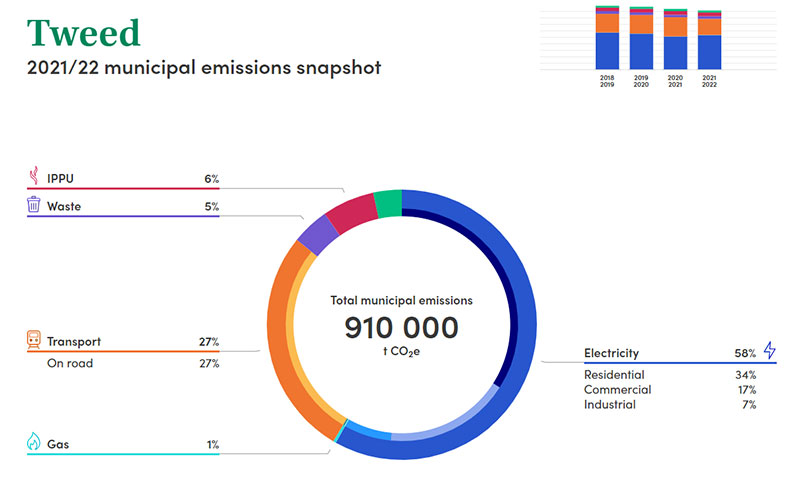Climate change
How will climate change affect us? Emergency declaration Climate Ready Tweed Global covenant Energy access and poverty plan Greenhouse gas emissions
How will climate change affect the Tweed?
In November 2022, Council received the final report from consultants BMT Commercial outlining the forecast impacts of climate change in the Tweed.
More hot days, more rainfall and sea level rise will impact our everyday use of electricity for heating and cooling, housing design and materials use for ventilation and flood resilience, and planning for housing, services and recreation. Additionally, local and protected plants and wildlife are adapting to changed conditions through migrating ideal habitat locations and breeding patterns.
 (JPG, 114KB)
(JPG, 114KB)
Trends in the Tweed's climate have been assessed and a summary provided below based on historical local weather data.
 (JPG, 112KB)
(JPG, 112KB)
The Tweed's wildlife, waterways, coastlines, utilities, infrastructure, businesses and communities are vulnerable to climate events.
 (JPG, 91KB)
(JPG, 91KB)
Present-day climate trends and future projections have been calculated using NSW Government data sources and CSIRO reports.
Read more in the consultant's full report(PDF, 4MB).
Find out more about climate change projections for the North Coast.
For Council’s assets, operations and programs, climate change poses significant impacts across the majority of Council functions. In its 2023 Climate Change Risk Assessment(PDF, 4MB) Council has described 135 risks ranked for the likelihood and consequences of their occurrence:
- 66 risks relate to infrastructure and assets
- 21 risks relate to community services
- 19 risks relate to environment management and protection
- 15 risks relate to corporate functions
- 13 risks relate to land use planning and development.
Find out more about what Council is doing to mitigate and adapt to climate change.
Climate emergency declaration
 (PDF, 511KB)At its 19 September 2019 Council meeting, Tweed Shire Council declared a climate emergency that requires urgent action by all levels of government, including by local councils.
(PDF, 511KB)At its 19 September 2019 Council meeting, Tweed Shire Council declared a climate emergency that requires urgent action by all levels of government, including by local councils.
Since this declaration, Council has completed numerous mitigation, adaptation and resilience improvements, and continues to make progress on ongoing climate actions. Check out Council's achievements in responding to climate change(PDF, 511KB) in the Tweed.
Council's Interim climate change action plan(PDF, 546KB) describes 57 greenhouse gas emissions reduction and climate adaptation actions in response to the climate emergency.
Find out more about Council's Climate Change Management Policy(PDF, 168KB).
Global Covenant of Mayors
More than 11,700 cities from 120 countries representing more than 1 billion people worldwide are part of a global alliance for local government climate leadership. Councils commit to advance climate action in three key areas:
- reducing greenhouse gas emissions
- identifying – and adapting to – the risks associated with climate change
- increasing access to clean and affordable energy
Check out Tweed Shire's reporting dashboard.
Energy Access and Poverty Plan
Council's commitment to advancing climate action includes increasing equitable access to clean and affordable energy. Following engagement with the community and community care service providers, we prepared an Energy Access and Poverty Plan(PDF, 4MB) to inform its response to the issue of energy affordability in the Tweed community.
The plan provides a summary of community experiences as well as proposing a range of possible solutions to reduce the percentage of Tweed households that spend more than 10% of their income on electricity. The goal of our Energy Access and Poverty plan is to reduce this percentage to below 2% or 1,000 households.
We are already taking action with our 'Flick the Switch' shopping centre pop-up and communication campaign to support community members in switching to the most cost-effective energy provider to reduce electricity costs. Find out more about the Home Energy Community Survey results.
Read the Energy Access and Poverty Plan(PDF, 4MB)
Climate Ready Tweed
From November 2022 to May 2023, Griffith University Climate Action Beacon conducted the most comprehensive baseline assessment of community perspectives towards climate action and disaster resilience. The project included 252 responses to a comprehensive climate action survey, 29 in-depth interviews and co-design workshops with 50 people.
Climate Ready Tweed Project: final report(PDF, 3MB)
Community Climate Action Workshops: summary of outputs(PDF, 930KB)
Community Climate Action Readiness Survey: technical report(PDF, 1022KB)
Tweed’s greenhouse gas emissions profile
Electricity in homes and businesses, transport fuels and waste are major sources of greenhouse gas emissions from across the Tweed.
From these major sources of emissions, we each create at least 11 tonnes of carbon dioxide emissions per person per year. Through clean energy choices, efficient transport and avoiding waste, governments, businesses and individuals can collectively reduce our carbon footprint to less than 4 tonnes CO2-e per person per year.
This will help us to avoid dangerous changes in global temperatures, increasing costs of energy, food prices and risks to the Tweed’s world class beaches, wetlands and forests, waterways, native plants and wildlife.

Source: snapshotclimate.com.au